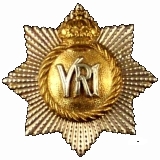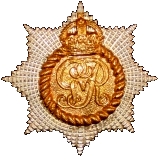
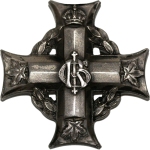
The First World War
Soldiers and Non-Commissioned Officers
of The Royal Canadian Regiment
477609 Private Clifford Moss, M.M.
By: Captain Michael M. O'Leary, The RCR
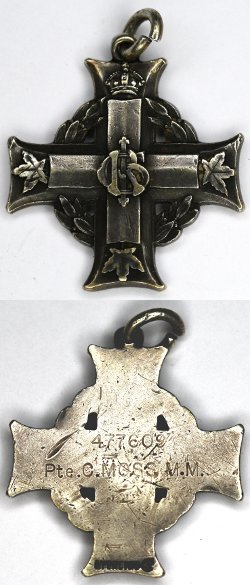
Memorial Cross sent to Private Clifford Moss' widow. (Private collection.)
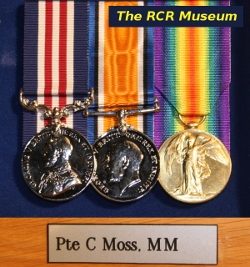
Medal group attributed to Private Clifford Moss in The Royal Canadian Regiment Museum. An examination of this medal group's naming in January 2010 revealed that while the Military Medal is named to Moss, the British War Medal and the Victory Medal are not. The latter two medals are named to Captain J.A. Blezard, C.A.M.C. -- Blezard's medals have been used to recreate a medal group similar to Moss'.
View a discussion thread examining this group at The RCR Forum.
In Sept 2010, The RCR Museum split the mixed Moss-Blezard group, and the single Military Medal awarded to Moss was remounted and displayed alone. The fate of Capt Blezard's pair is unknown.
Clifford Moss was born on 1 Jan 1894 at Leeds, Yorkshire, England. His father, Arthur William Moss, was a printer by trade. Moss emigrated to Canada before the First World War and decided to enlist in the fall of 1914 after the outbreak of war. Joining Canada's only Permanent Force infantry battalion, Moss was taken on the strength of The RCR in Bermuda on 30 Oct 1914. He was initially assigned the regimental number 16273.
The Royal Canadian Regiment served on garrison duty in Bermuda from September 1914 until August 1915. Following the Regiment's relief by the 38th Canadian Infantry Battalion, The RCR returned to Halifax where it was necessary that every member of the unit re-attest for overseas service in Europe. Accordingly, Clifford Moss attested for overseas service with The RCR on 23 Aug 1915.
On his attestation paper, Moss stated that he was a farmer by trade and unmarried. He identified his next of kin as his sister, Mrs W.G. Campbell, who was living in Bellwood, ON. Moss is described on his attestation paper as 5-foot 4 inches in height, with a 33-inch chest. He had a dark complexion, brown eyes and dark hair. He also had two distinguishing tattoos; a cross on his right forearm and a girl on his left forearm. It appears that he received the tattoo of the girl while in Bermuda as an earlier medical document does not identify it.
Shortly after attesting for overseas service, Clifford Moss found himself in hospital as a result of keeping questionable company. Being treated for gonorrhea, he was also subjected to the insult added to injury of receiving "Permanent Forces Hospital Stoppages" from 28 Aug to 7 Sep 1915 while he was in hospital. Moss' pay records show a stoppage of pay and field allowance during his hospitalization, for a loss of one week's pay ($7.70).
On 9 Sep 1915, a few days after his return to duty, Moss wais charged, found guilty and received a punishment of 168 hours detention. His crime, as documented in his service record, was "having in his possession the kit, etc., of a comrade." Unrepentant, Moss continued his life of creating strife for his Company Sergeant Major, and he was also found guilty of being absent from 6 a.m. to 8 p.m. 4 Oct 1915, for which he forfeited one days pay and allowances ($1.10).
Moss also continued to have health problems, and was hospitalized from 23 Oct until 8 Nov 1915. Being in hospital during this time also meant that he did not cross the Channel and enter France with the Regiment at the start of November 1915. As a result of the unit having proceeded overseas without him, Moss was transferred to the 11th Canadian Infantry Battalion, effective 25 Nov 1915.
Shortly after his transfer, Moss was back in hospital. Admitted to the Fairfield Hospital, Broadstairs, on 1 Dec 1915 Moss was diagnosed with Bronchitis. He would be discharged on 7 Feb 1916 after 69 days in hospital and pronounced fit for "light duties."
We can, perhaps, suspect that Clifford had too much free time while he rested in England and was supposed to be returning to a state of fitness for front line service. It would appear that he continued to frequent the wrong establishments and spend time with ladies of whom his mother might not approve. Once again, on 2 Mar 1916, he was admitted to hospital, this time the Military Hospital Shornecliffe and his diagnosis was again Gonorrhea Orchitis. After two nights in hospital, Moss was discharged on 4 Mar 1916.
Moss' release was short lived and he went back into hospital at Barnwell Military Hospital, Cambridge, on 6 Mar 1916 for continuing treatment of Gonorrhea. This time he would spend 38 day in hospital, being discharged on 13 Apr 1916.
Finally, almost six months after the Regiment had crossed the channel and started serving in the front lines, Clifford Moss would be pronounced fit for field service. On 23 Apr 1916 he proceeded overseas to The RCR in France and the next day was struck off strength of the 11th Battalion and, having proceeded to the Canadian Base Depot in France, was taken on the strength of The RCR.
On 1 Oct 1916, Moss would commence a monthly pay assignment to his sister in law, Mrs Arthur Moss of 8 Grace Terrace, Wortley, Leeds, England. Assigning $15 per month, Moss would maintain this pay assignment until cancelling it in March 1917.
Clifford Moss was granted 14 days leave to England commencing 24 Jan 1918. This was a particularly special trip for him as he had been granted permission to marry in accordance with Order in Council, P.C. 1872 of 6 Jul 1917. On 28 Jan 1918, Clifford Moss and Maud Farrar were married at the Parish Church in Leeds. At the time of their marriage, Moss was 25 years old and Maud was 31.
On 9 Feb 1918, Moss returned from leave and rejoined the Regiment in France. He also completed a new Will in his Pay Book stating: "In the event of my death I give the whole of my property and effects to my Wife, Mrs. C. Moss, 80 Canal St, South Wigston, Liecester, England." Moss also ensured that supporting payments would go to his new bride by starting a pay assignment of $15 per months commencing 1 Mar 1918. At the time, Mrs Maud Moss was living at 52 Lillian St, Wolseley Road, Leeds.
Clifford Moss continued to serve with the Regiment in France through the spring and summer of 1918. His records show neither a return to hospital nor any new interactions with the military's justice system. His luck in these areas, unfortunately, would not protect him from the actions of the enemy.
By the summer of 1918, Clifford Moss was demonstrating his skills as a professional and experienced soldier of the Regiment. Employed as a Company Scout, he would perform distinguished service and be successfully recommended for the Military Medal for his actions in battle in early August 1918. Recommended for an Immediate Award, with the documents prepared within days of his actions, the citation for Moss' Military medal is a rare surviving example of a late war MM citation.
Dated 17 August 1918, the citation reads:
477609 Private Clifford MOSS
For conspicuous bravery and gallant services during the attack on WHITE HOUSE on 8th August 1918 and the capture of PARVILLERS on 14th August 1918. As a Company Scout he fearlessly went forward time and again and returned with the most valuable information for his Company. In the darkness at PARVILLERS he advanced, under heavy shell-fire and machine gun fire to the outskirts of BLUCHER WOOD cutting lanes through wire and locating paths. He then led a Platoon to its objective, greatly assisting in its early security.
Sadly, Clifford Moss would not survive to see his award of the Military Medal published. Like many awards recommended in the closing months of the War, it would not be published in the London Gazette until after the Armistice. Moss' award of the Military Medal would be published in the Supplement To The London Gazette, 11 February 1919.
On 7 Sep 1918, Private Moss suffered "Shot Wounds" to his face and legs. He was transported to the No. 4 Casualty Clearing Station via No. 9 Field Ambulance. Moss was given an initial shot of A.T. Serum (Anti tetanus serum) at 1500 hrs that day, but his wounds would prove to be too severe. At 10.15 p.m. on 7 Sep 1918, Private Clifford Moss died of his wounds at No. 4 Casualty Clearing Station. Capt Ross Mitchell, CAMC, signed Moss Field Medical Card confirming the time of his death.
7-9-1918. - FIELD.
Heavy showers all day. Trenches at Battalion Headquarters flooded. Heavy enemy shelling in vicinity of Transport Lines causing casualties. Enemy shelled rear areas at night with H.V. Gun.
Lieut. W.H. POOLE returned from leave.
5 O.R's from C.C.R.C.
1 O.R. from C.C.S.
1 O.R. Killed.
15 O.R's wounded.
The Regiment's War Diary for 7 Sep 1918 shows that the Regiment was not involved in a pitched battle that day. The War Diary states that 1 Other Rank was killed and 15 wounded, the result of enemy artillery fire, which struck the Battalion's Transport Lines. We cannot be sure if Moss is the one noted as killed, or if he was counted as wounded and then died later that night. We do know that he rests between two other Royal Canadians in Duisans British Cemetery, and that all three died on 7 Sep 1918.
477609 Private Clifford Moss, MM, remains in France, he is buried in Duisans British Cemetery (Plot 5, Row H, Grave 31). To one side lies 477708 Pte John Pay and to the other 733119 Pte Isaac Zenas Weagle. Besides these three, there are three other Royal Canadians buried in Duisans British Cemetery.
As the widow of a fallen soldier, Maud Moss' further dealings with the military establishment would include the receipt of money owed to her late husband, and his medals and memorial items. Private Moss' pay account was finalized on 7 Jan 1919 and the amount of $203.13 (about six months pay and allowances) in accumulated pay would be forwarded to Mrs Moss, but a cheque would not actually be issued to her until 1 Apr 1919. Later, a "War Service Gratuity to Dependents of Deceased Soldiers" in the amount of $180 would also be authorized for payment to Moss' widow, although this was reduced by a prior payment of a Special Pension Bonus of $80. The remaining $100 would be issued by cheque on 31 Aug 1920.
Similar slowed by the sheer magnitude of the task, the issue of First World War medals and memorial items lasted for years after the end of the War. It was not until May 1920 that Moss' medals were sent to his widow. Moss received the Military Medal, the British War Medal and the Victory Medal for his service. (He did not proceed into France early enough to be eligible for the 1914-15 Star.) The next year, in Apr 1921, a Memorial Plaque and Scroll commemorating Clifford Moss' sacrifice were sent to his widow and finally, in Jan 1922, a Memorial Cross followed.
Pro Patria
- The O'Leary Collection; Medals of The Royal Canadian Regiment.
- Researching Canadian Soldiers of the First World War
- Researching The Royal Canadian Regiment
- The RCR in the First World War
- Badges of The RCR
- The Senior Subaltern
- The Minute Book
- Rogue Papers
- Tactical Primers
- The Regimental Library
- Battle Honours
- Perpetuation of the CEF
- A Miscellany
- Quotes
- The Frontenac Times
- Site Map

![]() The RCR in the Great War
The RCR in the Great War
![]() War Diary
War Diary
![]() Battle Honours
Battle Honours
![]() Battle Bars and The RCR
Battle Bars and The RCR
![]() The RCR Battle Bar Ledger (pdf)
The RCR Battle Bar Ledger (pdf)
![]() Honours and Awards
Honours and Awards
![]() Roll of Honour
Roll of Honour
![]() Prisoners of War
Prisoners of War
![]() Cemetery List
Cemetery List
![]() Cemetery Map
Cemetery Map
![]() Courts Martial
Courts Martial
![]() Officers
Officers
![]() RSMs of The RCR (1914-1919)
RSMs of The RCR (1914-1919)
![]() NCOs and Soldiers
NCOs and Soldiers
![]() An Officer's Diary (1914-1918)
An Officer's Diary (1914-1918)
![]() Recollections of a Nonagenerian (R. England) (1916-1919)
Recollections of a Nonagenerian (R. England) (1916-1919)
![]() On to Bermuda (1914-15)
On to Bermuda (1914-15)
![]() England and France 1915-1916 (Hayes; 1931)
England and France 1915-1916 (Hayes; 1931)
![]() Overseas with The Royals (1915)
Overseas with The Royals (1915)
![]() Regimental History Pamphlet (1917)
Regimental History Pamphlet (1917)
![]() Amiens (1918)
Amiens (1918)
![]() Cambrai (1918)
Cambrai (1918)
![]() Monchy-le-Preux (1918)
Monchy-le-Preux (1918)
![]() Under-aged Soldiers in The RCR
Under-aged Soldiers in The RCR
![]() Not All Were Volunteers; The RCR and the Military Service Act
Not All Were Volunteers; The RCR and the Military Service Act
![]() Sentenced to Death by Court Martial
Sentenced to Death by Court Martial
![]() The 7th Trench Mortar Battery
The 7th Trench Mortar Battery
![]() A Regimental Goat
A Regimental Goat
![]() Regiment and Family, Bermuda 1914-15
Regiment and Family, Bermuda 1914-15
![]() "March the Guilty Bastard In"
"March the Guilty Bastard In"
![]() Surrendered as Stowaway
Surrendered as Stowaway
![]() Re-Visiting the Great War Roll of Honour for The RCR
Re-Visiting the Great War Roll of Honour for The RCR
![]() Canadian Corps Trench Standing Orders (1916)
Canadian Corps Trench Standing Orders (1916)
